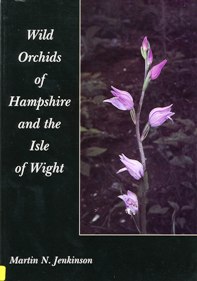Wild Orchids of Hampshire and the Isle of Wight

by Martin N. Jenkinson, follows on from his previous book ‘Wild Orchids of Dorset’, published in 1991. It was, of course, only fitting that Jenkinson should return to the county of his youth to complete this second book, published in 1995. Like all people who spend too much time around orchids he soon became an enthusiast and the book leans heavily on his years of experience and benefits greatly from it.
The book is laid out as a guide to the individual species, but commences with a number of chapters outlining aspects concerning orchids in Hampshire with specific regard to orchids. These chapters include the geology of the county, the relevance of habitat management, and discussion as to the pollination, germination and growth of orchids. The book is illustrated with 155 colour plates, which are particularly useful when considering the hybrids and varieties of orchids which exist in the New Forest. Also very helpful are the distribution maps which accompany each of the species, and allow one to see instantaneously whether the species is one of heath or chalk grounds. At the end of the accounts of species follows a chapter on the hybrid, ‘albino’ and abnormal plants which so often turn up amongst orchids and which are particularly relevant to the species of Dactylorhiza (Spotted & Marsh Orchids) which occur commonly in the New Forest.
The highest status orchid in the Forest is presently the rather lack-lustre Bog Orchid (Hammarbya paludosa) which is covered, as also some rarities once associated with the Forest, these being Summer Ladies’ Tresses (Spiranthes aestivalis) which became extinct in the British Isles after it died out in the Forest in the second half of the 20th century and Lesser Twayblade (Listeria cordata), a species found more frequently in the northern half of the British Isles, which appears to have been lost to the Forest about the same time, though has possibly been overlooked due to its diminutive nature and less than striking appearance. Indeed, much of the habitat still appears suitable for both of these ‘lost’ species, and there is the possibility that they will one day be re-found.
The book is, as you might expect from a specialist publication, quite a dense read, but not beyond anyone who is interested in the subject. It is a shame this level of detail is not available so accessibly for other families of local flora, not to say that orchids do not deserve the coverage they get, they certainly do, and this book is a reflection of that.

